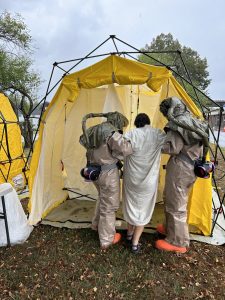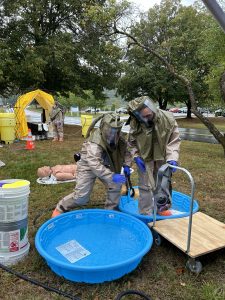NVRH emergency response team and other local agencies complete emergency drill
 ST. JOHNSBURY, VT (September 11, 2025) A rainy Saturday afternoon at Northeastern Vermont Regional Hospital (NVRH) provided a somber backdrop for a decontamination drill that simulated a train derailment with a chemical spill and mass casualties.
ST. JOHNSBURY, VT (September 11, 2025) A rainy Saturday afternoon at Northeastern Vermont Regional Hospital (NVRH) provided a somber backdrop for a decontamination drill that simulated a train derailment with a chemical spill and mass casualties.
The NVRH Hospital Emergency Response Team (HERT) took part in the drill on Saturday, September 6, along with fire departments from the towns of Lyndonville and St. Johnsbury, Lyndonville Rescue, Calex Ambulance and an ambulance team from Woodsville, NH, and the State of Vermont Hazmat team.
The drill started in Lyndonville and continuing to the NVRH campus on Saturday, afternoon with the goal of providing real-world training for local emergency response teams. Members of the hospital team used the drill to practice setting up the equipment, gearing up in PPE, and moving patients through the decontamination lines, with mannequins standing in for non-ambulatory patients.
NVRH Safety Officer & Emergency Management Coordinator Alissa Fontaine says that the NVRH team found the drill invaluable. Her important takeaways from the exercise included the importance of good communication between all teams, understanding how quickly an incident unfolds, and how long it takes to get responders properly geared up and ready.
“To be more successful in the future, we’re looking to mainstream processes to set up equipment, increasing organizational awareness and education so that we increase the number of active team members who will be able to respond quickly in a complex emergency situation like this,” she says.
NVRH’s Hospital Emergency Response Team is a multidisciplinary team trained to respond quickly and effectively to large-scale emergencies, including hazardous materials and decontamination events. The NVRH HERT team recently attended training at the Center for Domestic Preparedness (CDP) in Alabama and the drill was a chance to put their new skills and knowledge to the test.
“Exercises like this are essential to ensuring NVRH can respond effectively and safely in emergencies,” says Fontaine. “By practicing with our partners, we not only sharpen our own response but also strengthen the broader network that supports our hospital and community in times of need.”
